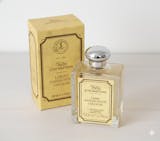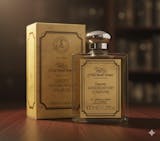Why are Safety Razors Better Than Cartridge Razors?

Photo by Sammy-Sander from Pixabay
There's a longstanding debate about whether cartridge razors are as good as safety razors and offer a smoother, closer shave. Nope.
While it may seem simple, the differences are vague and indistinct. The disparities become more pronounced once you understand the origins of the controversy and its various components. Have you ever heard of the empire?
Obviously, the cartridge razor is the dominant shaving model in our culture; we are inundated with media messaging in all its forms, including print and television, and indelible taglines such as "The best a man can get." Really?
The Gillette Fusion, for example, sold over four million cartridges last year. Most of the younger generation is taught to shave with a cartridge razor, and it is a common misconception that wet shaving with a safety razor comes with a luxurious price point and mornings spent covering your face with swabs of toilet paper, triaging nicks and cuts.
Nothing could be further from the truth.
It may be our obsession with speed (shave fast) and the prevalence of fake news. The rush of the rat race has led us like sheep down the inferior path. Fast food for breakfast, two-minute egg McMuffins, a shitty coffee, and a donut served in a drive-through. Digital assistants (Alexa, wake up) reading us aloud the top headlines of the day, a dedicated health food aisle in the grocery store, which begs the question: What is the rest of the market selling? Even McDonald's was in on the plastic razor trickery back in the '80s.
Everything has become a shortcut, and with these shortcuts, we have sacrificed quality. The rituals that were once part of our daily, enjoyable routine are now obscured. Fast-forwarded to the weekend warriors, and decades blurred.
There is a reason why today, double-edge safety razors make up over 80% of total safety razors sold. The only other alternative, in our humble opinion, is the straight razor. However, we understand that not everyone wants to use a straight razor; thus, the next best option is a safety razor—not a cartridge razor.
We have yielded our free thinking to the almighty powers of corporate marketing departments. They have led us to believe that there are profound differences between a double-edge safety razor and cartridge razors. Those marketing departments tell us that we aren't good enough to use a luxury good like a safety razor—they insist that the disposable cartridge razor is the one we should buy.
One blade, two blades, three, four, and five—they keep pilling on the blade, so we think we are getting more. Practical or pointless? We agree that safety razors are the hands-down choice for anyone looking for a great shave. Keep reading to learn why.
Welcome to the resurgence of the gentleman, a return to the indulgence and luxury of proper self-care, and the debate over safety razors vs. cartridge razors.
- The Current State of Shaving
- A Culture Shift Toward Wet Shaving
- What is a Safety Razor?
- What is a Cartridge Razor?
- Quality of the Shave: Safety Razor Vs the Cartridge Razor System
- How to Choose the Best Double-Edge Safety Razor?
- Which Safety Razor Should I Buy?
- Is the Cartridge Razor Really Bad All Around?
The Current State of Shaving
 Many men still rely on cartridge razors—quick but often leaving nicks behind.
Many men still rely on cartridge razors—quick but often leaving nicks behind.
Photo by Klaus Hausmann from Pixabay
Our broader culture prioritizes convenience over quality. We are taught that a quick shave is important. The cartridge razor has been successfully branded as being able to achieve that.
Double-edge safety razors are making a big comeback as men decide to break the mold and take back control of their shaving experience. The double-edge razor provides a closer shave, making the experience more satisfying. Of course, the double-edged safety razor costs a bit more, and you will need to make sure you resupply your shaves with fresh blades. But this is very little to ask in today's world of Amazon subscriptions and automated refills.
Invest in a good safety razor; it's much cheaper in the long run. It doesn't have the same devastating environmental consequences that the cartridge razor has, and quite simply, it just feels so damn good.
A Culture Shift Toward Wet Shaving
 Men are rediscovering the ritual of wet shaving.
Men are rediscovering the ritual of wet shaving.
Photo by Renee Olmsted from Pixabay
As wet shaving aficionados, we are truly exhilarated by the resurgence of the double-edge razor. The increasing number of men who are more intentional about their shaving is inspiring. There are even innovative shaving companies, like Henson, seeking to modernize traditional razors with new technology.
Many men today shave every day and want that practice to be sacred and meditative, and I couldn't agree more. You may want to look better and achieve a closer shave, and it's as simple as that. For whatever reason or motive that ushers you to the DE safety razor and the end of multi-blade cartridge razors, it is unmistakable that more blades clearly don't equate to a better shave.
Nobody wants a lousy shave. Imagine a morning that begins with the steam of hot water and a shaving bowl or scuttle, a shaving brush at hand, the right shaving soap and shaving cream—lathered to a buttery perfection—alum blocks for soothing, and perhaps a styptic pencil for those minor nicks and cuts. Clearly, you are on the path to the best shaving experience you have ever had. You will never look back.
What is a Safety Razor?
Gillette Razor Patent by K. C. Gillette, Public domain
Source: Wikimedia Commons
Before buying any new razor, it’s essential to know what each one looks like. There are two main types of safety razors: disposable single-edge and classic double-edge razors—the primary difference between the two lies in the number of blades and the razor’s overall design. While cartridge and disposable razors dominate most retail shelves, double-edge safety razors are more commonly found online or in specialty grooming shops.
The history of the double-edge safety razor is as quintessentially American as it gets. The classic double-edge safety razor was invented and patented by King Camp Gillette in 1904, gaining popularity when it was issued to U.S. military personnel during World War I. The handle was permanent, and the disposable blade light; shaving was quick and efficient. It made sense to carry one in a military mess kit rather than a straight razor with all its accoutrements.
When most men returned from war, they maintained that tradition of wet shaving. Since then, the double-edge (DE) safety razor has declined in popularity in favor of faster methods such as the cartridge razor, the disposable razor, and the electric razor—all tools that were marketed as convenient and easy.
What is a Cartridge Razor?
 Cartridge razors offer convenience but create lasting waste.
Cartridge razors offer convenience but create lasting waste.
Photo by Steve Buissinne from Pixabay
What are cartridge razor systems and their history? Cartridge razors were invented in the early seventies and touted as a smoother and more comfortable shave. Since their invention in the '70s, we have seen the cartridge razor evolve from plastic bodies and handles with single surgical steel blades to complex systems with flexible blades. Recently, the multi-blade cartridge systems have become popular. But wait, they've also added vibration and heat. Popular not only for convenience but for the flattened learning curve. Just about anyone can pick up a cartridge razor and get a smooth shave.
Environmental Impacts of Cartridge Razors
All the disposable elements of the cartridge razor that end up in the trash ultimately end up in the landfill. I have a lasting image in my mind of heaps and heaps of multicolored plastic razor handles piling up in a landfill. The plastic doesn't break down. It just accumulates.
There's no way to recycle plastic disposable razors or the blade cartridges. Anything that's a hybrid of metal and plastic can't be recycled.
With the individual safety razor blades, though, they're so small that you can keep them all in a blade disposal tin.
Some recycling centers will take your full tin of disposed blades.
Many American houses built before 1970 even have a blade disposal slot in the medicine cabinet for individuals to discard their blades. (They sit in between the wall and the medicine cabinet for eternity, but at least they're not in a landfill.) Out of sight, out of mind.
Quality of the Shave: Safety Razor Vs the Cartridge Razor System
 Safety razors deliver a closer, smoother shave with less irritation.
Safety razors deliver a closer, smoother shave with less irritation.
Photo by Henson Shaving
It's true that a traditional wet shave with a safety razor takes longer and requires more technical expertise. However, the implement doesn't have such glaring limits as its disposable counterparts, which can never truly yield the closeness that a double-sided razor blade offers.
The most popular cartridge razors have three blades. Sometimes they have even more blades, as many as five. Next year, we might see that number go to six. The logic is that they all interact with your skin separately, so the second blade accounts for what the first one misses.
However, the reality is that increased blade contact with the face irritates your skin. Cartridge razors are much more likely to yield razor bumps and razor burn. You deserve to have something more loving on your face.
The DE safety razor features a single exposed blade on two sides that can be alternated, maintaining a sharp edge with every pass, whether against or with the grain, and treating your skin more gently. Less repetitive passes on the skin result in a relatively irritation-free shave, fewer razor bumps, and a reduced risk of redness from razor burn.
Safety Razor Vs Cartridge Razors FAQs
If you have sensitive skin, the undeniable better choice is the double-edged safety razor, and changing your safety razor blade every 3 to 5 shaves is recommended.
-
How close a shave can I get with the different types of razors?
A straight razor gives you the closest shave possible. A safety razor is a close second, and the worst possible shave is with an electric razor.
-
Why do I need shaving creams and oils to wet shave?
Cartridge razors feature built-in plastic guards and lubricating strips, providing a smooth glide across the face. Traditional DE safety razors rely on blade aggression (distance of the razor blade from the safety bar). Therefore, high-quality shaving soaps and creams are crucial for adequate lubrication. You should also learn about shaving angles as you map your face before shaving. Don't forget to replace your old blades regularly—always use sharp blades.
-
Why are the angles important in shaving?
With the DE razor, you have more freedom to decide what angle suits you best, better balance and leverage of the razor blade, and the best angle for your contours. In contrast, a disposable type typically features a single blade angle for all. And double-edge razors aren't just for men and facial hair; more women are turning to the classic DE razor more than ever.
-
Will I cut myself using a safety razor?
You can indeed be more vulnerable to nicks and cuts, especially as a beginner. We are going to be honest—you will likely cut yourself a few times in the beginning. Be extra careful above your lip around your nostrils, which tend to have difficult angles. There's a learning curve, but in time, safety razor shaving becomes second nature and instinctual. Just like learning to ride a bike, you are going to fall off a few times.
-
Is the quality of steel a factor, too?
The quality of steel also plays a role in the quality of the shave. Because cartridge razor companies are so indiscreetly implicated in a disposable product market, it's not hard to believe the quality of the razor blade steel is, on the whole, much worse, often using inferior quality steel. In contrast, double-edge blades are always made from medical-grade stainless steel.
In addition to the superior shave it brings, the DE razor is better for the health of your facial hair. The multi-blade razor system makes you more likely to develop ingrown hairs than if you were to use a safety razor.
Economics
The disposable safety razor and cartridges may appear cheaper upfront because their price tag is less for the entire system; however, that system is flawed, more expensive, and contributes to waste in landfills that never degrade.
Disposable cartridge razors are cheaper in every aspect; the body and handles are designed to be disposable, whereas a high-quality beginner safety razor can last for years, if not decades.
If we focus on the business end, razor blades cost the same, so where is the economic difference? While you may achieve a similar (and, in our opinion, inferior) performance, a significant portion of what you are paying for with cartridge razors is marketing.
When was the last time you saw an advertisement for double-edge blades?
Double-edge blades are inexpensive, at around 10 cents per blade, offering up to 5 close and comfortable baby butt smooth shaves. They come in compact packs of 5 or 10, as well as bulk saver packs of 100. While the blades all dull at the same rate, depending on the coarseness of hair, the short lifespan of double-edge blades also ensures that your shaving routine remains sterile and clean.
I'll offer an example:
A 20-pack of cartridges for the Gillette Mach 3 Turbo costs $30. If you shave every day, you'll need to change out the cartridge more than once a week. You'd probably buy five of those 20-packs of cartridges per year. And if you're not so savvy, perhaps you'd buy the 6-pack or 10-pack, which costs more per cartridge. (The short-run thinking is what makes people opt for the cartridge razor anyway, so that feels like a safe assumption.)
A reusable safety razor handle costs less (of course, you can buy nicer, more expensive ones, but a standard one is available for under $100). And the disposable blades—the only part of the safety razor shave that requires replacement—are cheap: some 100-packs cost under $15.
You could replace the blade every shave and still save money, even within a year. Over a more extended period, you save even more money. You might only have to buy one safety razor handle in your lifetime (depending on how many mechanical parts it has).
Differences in Design
 Cartridge razors pivot for ease, while safety razors give you full control.
Cartridge razors pivot for ease, while safety razors give you full control.
Photo by Gutzemberg on Depositphotos
-
The Head
The main difference between a safety razor and a cartridge razor is that they have a pivoting head, which allows the cartridge razor blades to interact with your skin at the angle that is required, without any technicality, passing over your face's natural contours.
Safety razors, also known as double-edged safety razors, are a traditional shaving tool that features a fixed head, which does not pivot. The shaver is in control.
-
The Lubricating Strip
Another difference is that cartridge razors have built-in features that condense the shaving process into a single step. They have a lubricating strip and a comb built right into the cartridge, along with the multiple blades.
Safety razors don't have any of that. You will need to bring your own shaving kit and accessories, including shaving cream, shaving soap, etc.
-
Length and Weight of the Razor
Cartridge razors are upwards of five inches in length, and safety razors are usually in the three-and-a-half-inch range. They're much shorter.
Cartridge razors weigh less than safety razors, though the specific weight depends on the materials that compose the razor. Plastic weighs less than steel.
How to Choose the Best Double-Edge Safety Razor?
Mild to aggressive, handle length and grip (knurling), and who can ignore style. You must know yourself and your skin, and experiment and level up as you acquire skills and further meet shaving performance demands.
There are multiple types of safety razors, and understanding their differences will help you choose the one that best suits your needs. They can be broadly categorized into one-piece, two-piece, or three-piece double-edge safety razors.
What are the Different Types of Safety Razors?
The one-piece, double-edged razor (also known as a butterfly razor) is popular for its ease of use, particularly in replacing blades. They're challenging to clean, though, and because they have numerous mechanical parts, they may not last as long as some of the other types. The two-piece model is similar in terms of how easily it can be fitted with a new sharp blade, but it has fewer mechanical parts, which means it lasts longer.
With the three-piece, it's easier to keep your safety razor clean and your shaving tools sterile.
What Other Variations of Safety Razors are There?
You should opt for an open comb razor if you have coarse, thick facial hair. Otherwise, the closed-comb razor provides a comfortable shave.
Another consideration is the aggressiveness of the safety razor blade. A more aggressive razor head exposes the razor blades more, which can improve the shave quality if you're skilled. As I mentioned, there is a learning curve if you're angling for a precise shave.
Another consideration is the handle: if you have bigger hands, you'll want to choose one of the safety razors with a longer handle. The inverse is true of smaller hands.
Which Safety Razor Should I Buy?
Choosing the best safety razor is about knowing yourself and your preferences. However, these three safety razors are among the most popular double-edge safety razors available.
REX AMBASSADOR XL ADJUSTABLE SAFETY RAZOR STAINLESS STEEL
It helps prevent skin irritation, especially for individuals with sensitive skin, but is also beneficial for all skin types. It's adjustable to six different settings, which means you can get a very close shave if you want, but you decide the degree of closeness.
It's made of premium stainless steel, and the handle features a deep knurled grip, ensuring your hands stay in place for a smooth shave. This double-edge razor will make you want to ditch cartridge razors and electric razors for good.
EDWIN JAGGER CHATSWORTH DOUBLE EDGE SAFETY RAZOR BARLEY HANDLE
It's a classic double-edged safety razor, but the handle was manufactured to be heavier and also features an intentionally lower center of gravity, allowing for a shave that requires only gentle guidance.
It comes with a five-pack of Feather Hi-Stainless Japanese double-edged razor blades. All Edwin Jagger products come with a guaranteed lifetime of use.
Edwin Jagger products are also primarily made in Sheffield, England, which is where the first stainless steel razors were manufactured in the early 1900s.
HENSON ALUMINUM AL13 MEDIUM SAFETY RAZOR
The Henson Shaving AL13 Medium Safety Razor is crafted from aerospace-grade aluminum. It features a wider blade gap than the AL13 mild razor, catering to those who prefer a slightly more aggressive blade or who enjoy wet shaving with a medium blade gap exposure and medium aggression, ideal for individuals with coarser hair.
Is the Cartridge Razor Really Bad All Around?
In short...yes. It really depends.
The only viable argument in favor of the cartridge razor is that it's convenient. As a razor customer, if your top priority is convenience, then a cartridge razor might be the right choice for you. If it's a chore that you need to get out of the way, the cartridge razor truly does bring a faster shave.
Some factors come into play with safety razors that aren't concerning for people who use cartridge razors: Do I have to dry the safety razor? How do I store it properly? How do I clean it? Which replacement blades do I prefer the most?
If you don't want to think about any of that, sign up for the Dollar Shave Club. A new razor head will come in the mail every so often, and you can throw it away when you're done with it. You don't have to think too hard about it. By now, you should know the drawbacks to that approach, though.
Updated 11/20/23
Related Articles
Why are Single Blade Razors Better Than Five
Safety Razor for Women? Why More Ladies are Making the Switch
Ultimate Buying Guide for the Best Safety Razor for Beginners 2025






























Thanks for sharing your experience, Robert! The 1906 Gillette is truly a classic—glad to hear it’s still delivering great shaves. You’re absolutely right about the importance of a good shave soap for both glide and skin health.
The best razor is the original gillette such as a 1906 i use daily.
The shave soap is important also.
It lubes as you shave for smooth glide of razor on shin. Also the soap cleans your face to remove dirt grime out of skin pores helping not get acne. Shave with hot water when done rinse with cold…
Leave a comment